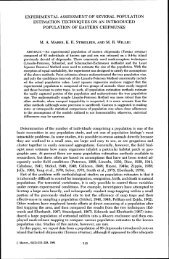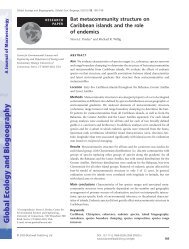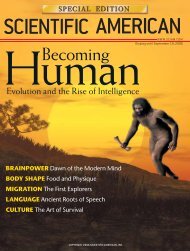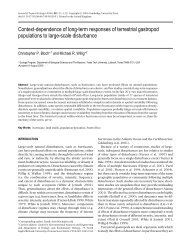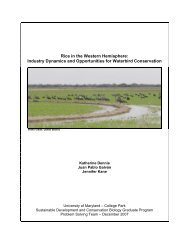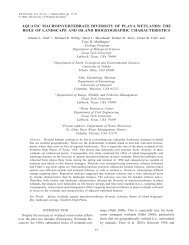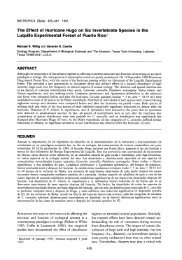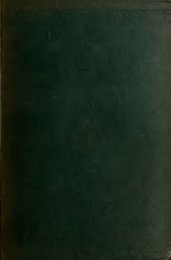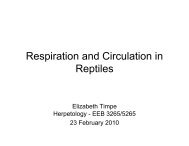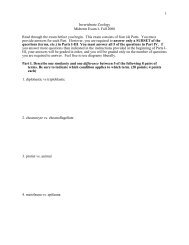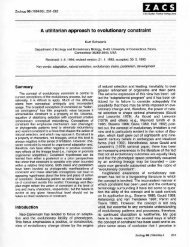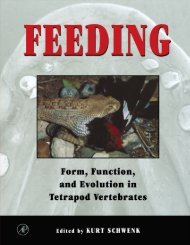Tadpole shrimp structure macroinvertebrate communities in playa ...
Tadpole shrimp structure macroinvertebrate communities in playa ...
Tadpole shrimp structure macroinvertebrate communities in playa ...
Create successful ePaper yourself
Turn your PDF publications into a flip-book with our unique Google optimized e-Paper software.
Figure 1. Means and standard errors of PCA factors contribut<strong>in</strong>g<br />
to significant differences among treatments for tadpole<br />
<strong>shrimp</strong> reduction trials (white circles) and control trials (black<br />
circles). Area of each circle <strong>in</strong>dicates the relative size of PCA<br />
factor 7: <strong>in</strong>creas<strong>in</strong>g circle size reflects <strong>in</strong>creas<strong>in</strong>g abundances of<br />
Diaptomidae and Sm<strong>in</strong>thuridae, and decreas<strong>in</strong>g abundance of<br />
Culicidae.<br />
was no significant <strong>playa</strong> x treatment <strong>in</strong>teraction.<br />
Significant differences between treatment and control<br />
microcosms were primarily due to the responses<br />
of PCA factors 1, 4, and 7 (Table 4). This predom<strong>in</strong>antly<br />
reflected higher abundances of ostracods,<br />
Psychodidae, and Culicidae, and reduced abundances<br />
of Mo<strong>in</strong>idae, Diaptomidae, and Sm<strong>in</strong>thuridae,<br />
when tadpole <strong>shrimp</strong> were removed (Fig. 1).<br />
The abundance of Cyprididae was greatest<br />
when tadpole <strong>shrimp</strong> were removed (Table 1) and<br />
was correlated negatively with tadpole <strong>shrimp</strong><br />
abundance <strong>in</strong> control microcosms (Fig. 2). Many<br />
taxa, however, ev<strong>in</strong>ced elevated abundances when<br />
tadpole <strong>shrimp</strong> were present compared to their<br />
abundances <strong>in</strong> reduction treatments (Table 1).<br />
<strong>Tadpole</strong> <strong>shrimp</strong> abundance was correlated positively<br />
with Streptocephalidae abundance and<br />
Sm<strong>in</strong>thuridae abundance <strong>in</strong> control microcosms<br />
(Fig. 2). Partial correlation coefficients further<br />
confirmed that tadpole <strong>shrimp</strong> had direct, positive<br />
effects on abundances of Streptocephalidae and<br />
Sm<strong>in</strong>thuridae (Fisher’s test, v 2 ¼ 16.6, p < 0.001<br />
and v 2 ¼ 12.5, p ¼ 0.017, respectively).<br />
For some taxa, the effects of tadpole <strong>shrimp</strong><br />
removal contrasted patterns with<strong>in</strong> control<br />
microcosms. Abundances of Mo<strong>in</strong>idae and Diaptomidae<br />
tended to be higher <strong>in</strong> control microcosms<br />
than microcosms from which tadpole <strong>shrimp</strong> were<br />
Figure 2. Relationship between tadpole <strong>shrimp</strong> density and abundance of (a) Mo<strong>in</strong>idae, (b) Cyprididae, (c) Sm<strong>in</strong>thuridae, and (d)<br />
Streptocephalidae <strong>in</strong> control trial 2 (open circles, dashed l<strong>in</strong>e) and control trial 4 (black circles, solid l<strong>in</strong>e). Results of Fisher’s test for<br />
comb<strong>in</strong><strong>in</strong>g probabilities from Spearman rank correlations <strong>in</strong> each control trial are given. The th<strong>in</strong> horizontal l<strong>in</strong>e <strong>in</strong>dicates the average<br />
abundance of each family <strong>in</strong> treatment microcosms.<br />
145



